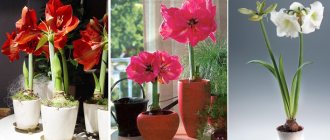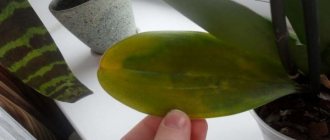According to most gardeners, caring for sansevieria (the official name of the plant) is a complete pleasure. The only thing is that you need to clearly know how to transplant your mother-in-law’s tongue at home so that it continues to delight you with its bright leaves. The manipulation itself is not so complicated, but it does imply the presence of certain features.
It only needs to be done when the roots of the plant have filled the entire pot. Despite its unpretentious appearance, not a single flower can tolerate cramped conditions and forced restrictions. To carry out the manipulation, you do not need to have any special skills, you just need to strictly adhere to the basic technical recommendations.
Lighting
In its homeland, Sansevieria grows in conditions of strong solar activity. However, it does not necessarily need to be in the sun to grow and develop.
Mother-in-law's tongue feels great in diffused light and partial shade.
Sansevieria is very unpretentious, but variegated varieties require more light and may even lose their color if there is not enough light.
Direct sunlight does not harm sansevieria at all , so if it is exposed to the sun for several hours a day, no sunburn will appear on the leathery leaves.
Step-by-step instructions for planting a flower
The roots of the flower grow not deeper, but wider, and sometimes, having freed the plant from the old pot, the owner is surprised to contemplate the huge root spiral with young shoots on it. In nature, the root, not limited by anything, grows as it pleases, and new shoots of sansevieria simply emerge from the ground along its entire length.
- sharp knife;
- a new pot (or several, depending on how much the sansevieria has grown);
- drainage;
- soil for succulents or neutral for decorative foliage plants (you can find out what soil for sansevieria should be like here);
- a little crushed activated carbon.
Procedure:
- Run the blunt side of the knife inside along the edge of the pot to separate the earthen lump.
- Remove the sansevieria from the pot and carefully shake off the old soil from the roots. This can also be done in a bowl of water by rinsing the roots.
- If there are a lot of young plants, carefully cut the rhizome with a knife, leaving the growing points. Treat the cut areas with charcoal. It is advisable to separate the children from the mother plants. Leave it to dry for a day or put it in water, but both are not necessary for successful rooting.
- Pour expanded clay into the bottom of new pots according to the number of plants.
- Install a new sprout in each one and sprinkle it well with soil, compact it, water it and, if possible, strengthen it until the end of the plant’s adaptation period.
Watering
Sansevieria stores a large amount of moisture in the rhizome, and hard leaves evaporate it very poorly. Therefore, this plant does not need abundant watering and is even harmful. It is adapted to water shortages and dry soil.
Water the sansevieria so that the lump of earth dries out at least 2/3 . In summer, the flower needs to be watered well once every 10 days, and then the substrate in which it grows should be dried.
In winter, watering is reduced, watered once every 2-3 weeks, depending on the room temperature. Sansevieria is not picky about the temperature and composition of water. However, you should not water the plant with cold water.
How to care for mother-in-law's tongue at home?
The plant is quite undemanding, adapts well to various conditions, requires moderate watering and can grow well in various lighting conditions. Propagation by seeds is practically not used for this plant. Vegetative propagation is used at home and in nurseries. Even under unfavorable conditions, the flower will be viable, but growth may slow down and loss of decorative value may occur.
The optimal air humidity is 70%, and the temperature is from +16 to +30°C. Precautionary measures:
- Regular feeding;
- dust and dirt from leaves and splashes;
- Ambient air humidity up to 70%.
- Replant as the flower grows or immediately after purchase;
- moderate, irregular watering;
- Maintain the temperature in the room where the flower grows between +16°C and +30°C;
Lighting
The light must be suitable for the flower. The most favorable location is on the south side of the house. However, during the summer months it should be possible to provide shade.
Watering
The intensity of watering depends on the vegetative state of the plant, ambient temperature and humidity, time of year and light intensity.
Watering rules:
- The plant is drought-resistant; in summer it should be watered once a week after the top layer of soil has dried.
- If the weather is cloudy and not hot, water once every 10 days.
- In winter, watering should be limited to once a month at a temperature of +20°C, after the top layer has dried.
Watering conditions:
- When watering, avoid getting moisture at the base of the leaves, as this can cause disease.
- It is best to use melt or rain water, but if this is not available, you can use settled tap water.
- Irregular watering and waterlogging can lead to the development of fungi, rotting and yellowing of leaves.
Spraying
If the room has sufficient humidity and low temperatures, hemlock does not need to be sprayed. Drops of liquid inside the rosette can cause rotting and death of the plant. To maintain a presentable appearance, it is enough to wipe the plant with a cloth.
Humidity
Indian gladiolus comes from steppe and semi-desert regions, so the hedgehog is adapted to life in an environment with very dry air; High humidity can lead to plant diseases. Humidity above 70% increases the risk of developing leaf and root rot.
Temperature
The plant feels very good in summer. The most favorable temperature is +16°C. Maximum permissible temperature +5°C; low temperatures favor diseases of the root system.
Priming
In the leopard lily's natural habitat, the soils are light, nutrient-poor and loose. There is special soil available for sale for cacti and other succulents. You can prepare a mixture at home to soothe your mother-in-law's tongue. For soil, you need to mix in equal proportions coarse sand, turf, and leaf soil. To control parasites and their larvae, bake the soil in the oven or microwave before planting. Let the soil cool and then replant the plant.
Feeding
There are certain rules that must be followed when applying fertilizers:
- refusal of additional feeding in the winter months;
- Fertilize leopard lily varieties carefully, excess nitrogen can cause an increase in chlorophyll in the stems and loss of bright color, the leaves can become very green,
- In early spring and autumn, it is enough to feed the plant once a month.
- Fertilizers should be applied most actively in the summer months - 2 times from May to September;
- It is preferable to use special succulent food; if it is not there, you can use mineral food in small doses; next month, if well tolerated, the dose can be increased;
What kind of pot do you need?
The preferred materials for pots are ceramic, glass or plastic. Reed chicory does not have a deep root system, most of the roots are close to the surface, so a large pot is not needed. However, the hemlock tongue has significant mass, so the weight of the pot must be significant. In this case, the above-ground part of the plant will not outweigh the pot with the root system. As the hemlock matures, the diameter of the pot should increase. Each subsequent pot should be 2-3 cm larger than the previous one.
Root system of mother-in-law's tongue
Is it possible to trim?
The growth zone of Sansevieria leaves is close to the stump, so there is no need to specially cut it out. This may stop the plant from growing. Trimming the lower leaves is a controversial issue. Some botanists recommend plucking off wilted lower leaves to prevent fungal diseases and plant rotting. Other gardeners are wary of pruning leaves because the wounded surface can become a breeding ground for pathogenic bacteria.
How to replant a flower?
Transplanting mother-in-law's tongue is very similar to replanting many indoor plants. The best time is from March to June. The need for replanting can be judged by the raised root ball, which indicates strong growth of the root system. Young plants are very vigorous and require a large pot and annual replanting. With each replanting, the size of the pot should be increased by 2-3 cm. Mature plants should be replanted every 3-5 years. If the plant was purchased in a store, it is worth replanting it in a pot with new soil.
One of the signals for transplanting sansevieria
Rules for transplanting flowers:
- Remove the root system from the pot along with the root ball and check if the roots have rotted. Damaged areas should be cut off.
- At the bottom of the pot, approximately one third of the height of the pot, place a layer of drainage, which can be pebbles, clay pebbles or tile chips.
- Then a small layer of soil or a special substrate for succulents.
- Place the plant in the pot and cover it with the same substrate; you can knead the soil from time to time to stabilize it in the pot.
- Finish the replanting with abundant watering.
- When replanting tall plants, provide the mother-in-law with twine to prevent the pot from falling.
Reproduction of mother-in-law's tongue
The method of propagation depends on the variety. Species with colored leaves can only be propagated using rosettes. Species with single-color leaves can be propagated by rosettes, shoots, cuttings and rhizomes.
There is a division - breeding varieties with plain or colored leaves.
Distribution methods:
- In the spring, break out the shoots. Using a sharp knife, separate the young shoot from the mother plant. Sprinkle the cuttings with crushed charcoal and replant the young shoot.
- Dividing the rhizome is the most effective method of propagation and preserves the characteristics of the species. The mother plant is divided into three or four parts, depending on the size of the root. The root must be preserved at each growing point. The offspring are transplanted into new pots. Spreading mother-in-law's language
- Propagated from the leaves of the highest varieties of mother-in-law's tongue. Cut off a healthy leaf of the plant and divide it into pieces of 5 cm each. Don't forget to mark the top and bottom of the sheet. Leave parts of the leaves in the air for 12-24 hours, then place them in river sand with the root part down, slightly tilted, one-third. Cover the plant with a plastic bottle and leave for 30-45 days for roots to form.
The soil
In nature, Sansevieria grows on depleted rocky soils of semi-deserts. But in apartment conditions it is not at all necessary to plant it in an earthen mixture for succulents.
The plant is not susceptible to rotting, so mother-in-law’s tongue grows best in a universal soil mixture with the addition of raising agents : brick chips, perlite, fine gravel.
You can mix the substrate for planting sansevieria yourself. The most optimal composition: 4 parts turf soil, 1 part sand, 2 parts leaf soil, 1 part brick chips.
Rules for placing plants in open ground
If the climate allows and at night the temperature outside never drops below +15 o C, you can decorate your garden with sansevieria. It is better to carry out this work in late spring or early summer.
The planting site should be well lit, but not exposed to direct sunlight.
- To do this, first prepare the soil. You can compose it yourself from the following components:
- peat;
- sand;
- leaf soil;
- humus.
Then holes about 15 cm deep are made in the soil into which new plants will be planted. Plant sections should already be treated with crushed activated carbon.- Drainage is added to the bottom of the holes - small stones, expanded clay, broken shards.
- Prepared soil is poured onto the drainage layer.
- Install young plants with a height of 20 cm and 5 leaves per bush.
- Add more soil, water a little and press down the soil until the plant is completely fixed.
Humidity
Existing in steppe and semi-desert climates, the plant has adapted to very dry air. Therefore, it is not necessary to maintain a certain humidity in the room where Sansevieria grows. In conditions of high humidity, the plant also does well, although the risk of root rot increases.
Sansevieria is not sprayed . It does not require high air humidity, and water getting inside the outlet can lead to its rotting. In order for the flower to have a beautiful appearance and not be dusty, it is enough to periodically wipe the leaves with a damp cloth.
Planting and caring for sansevieria
- Flowering: decorative deciduous plant.
- Lighting: partial shade, bright diffused light.
- Temperature: normal for residential premises. In winter, not lower than 16˚C.
- Watering: regular, moderate, more frequent in summer than in winter.
- Humidity: normal for residential premises.
- Feeding: during the active growing season, once a month with a fertilizer solution for cacti or decorative foliage plants.
- Rest period: not clearly expressed.
- Repotting: when the pot becomes too small for the plant.
- Reproduction: vegetative (by rhizome division or leaf cuttings).
- Pests: mealybugs, thrips, spider mites.
- Diseases: anthracnose, root rot.
Sansevieria , or sansevieria , or sansevieria , is a genus of the Asparagus family (in some catalogs - Agaveceae), which includes more than 60 species of evergreen perennial stemless plants from the rocky, dry regions of the tropics and subtropics of Africa, Madagascar, South Florida, Indonesia and India. This unpretentious and therefore popular indoor plant in different countries has received the nicknames “pike tail”, “snake skin”, “mother-in-law’s tongue”. Its value is that it is indestructible: you can forget about it for a week or two, and it will not die or dry out. In addition, the Sansevieria plant is happily used by designers to create flower arrangements and decorate interiors.
Diseases
Sansevieria is a plant that is very resistant to various infectious and fungal diseases.
Sometimes, when the soil is heavily waterlogged, root rot develops, and when water gets into the rosette, the leaves rot.
To preserve the plant, it is enough to reduce watering, dry the soil, and remove the affected rosettes.
Pests very rarely settle on sansevieria . Sometimes you can find mealybugs or scale insects, but the pests do not breed here in large numbers.
Therefore, they are often limited to only mechanical removal of harmful insects. If it is not possible to destroy the pests, you need to spray the plant with insecticidal preparations.
Why is the flower crying?
During the flowering of some types of sansevieria, small transparent drops form on the stem of the peduncle under each bud. The common people believe that this is how the plant cries. In fact, the pike tail secretes sweet nectar in a similar way, which attracts pollinating insects. Sometimes nectar appears on leaves and flower segments due to mechanical damage.
The “crying” of a flower is directly related to the flowering of the plant and enhances the accompanying signs. If flowering associated with the release of nectar occurs in winter, then unpleasant events and quarrels cannot be avoided; if in summer, then favorable changes will certainly come.
Problems
When growing sansevieria, even novice gardeners rarely have problems. But sometimes, due to significant errors in care, this flower can even die. It is necessary to regularly inspect it and analyze changes in its appearance.
Most often, the plant suffers from excessive watering. In this case, the leaves turn yellow and die, and they become soft. If you do not reduce watering, the root system may begin to rot.
With a lack of moisture, if sansevieria is not watered for months, the leaves become limp and wrinkled.
With prolonged exposure to low temperatures, the growth of the flower slows down greatly, then its leaves wither and die. In this case, if the temperature in the room is not increased, the plant may die.
When there is insufficient lighting, thin, weak leaves grow, and Sansevieria stretches out . Variegated varieties may lose light stripes or borders in the dark. If left in a dark place for a long time, brown spots may appear on the leaves, especially if over-watered.
How it blooms and how to propagate
Many people believe that Sansevieria does not bloom. In fact, it is blooming. And at the end of flowering, berries are formed that contain seeds. Therefore, mother-in-law’s tongue propagates not only by cuttings, but also by seeds.
- Ripe berries need to be collected and planted in a tray to a depth of about a centimeter. The distance between seeds is 5 centimeters. Prepare the soil in the same way as for replanting. Place a tray with
- seeds in a bright, warm place, cover with film and wait for germination. The first ones will hatch in two weeks. As soon as the plants get stronger, they can be planted in pots.
It’s easier and faster for “mother-in-law’s tongue” to propagate by cuttings. Separate the cutting, leave it in the air for 10 minutes to dry the cut, and then plant it in the prepared soil.
You can divide the roots that have green rosettes. It is better to do this when transplanting, in the spring.
If there is a yellow edging on the leaves of your mother-in-law's tongue, none of the propagation methods described above will work. Only the leaves need to be divided.
- Cut a healthy leaf at the base at a 30-degree angle.
- Place the leaf in the pink manganese solution.
- Then lift it so that only the yellow corner is in the manganese solution.
- Roots will appear from there.
- Also plant at an angle.
- When sprouts appear, cut off this leaf with a sharp knife.
Reproduction
In apartment conditions, Sansevieria propagates very easily by vegetative means. To propagate Sansevieria or mother-in-law's tongue, separate rosettes, parts of rhizomes and cut leaves are used.
The rosette, separated from the plant, and rhizome fragments are planted directly in separate permanent pots. This procedure is carried out in spring or summer during the growing season.
When dividing the rhizome, it is important that the planted part has at least one growth point. Then, with moderate watering of the shoots, they soon begin to grow and send out new shoots.
Sansevieria can be propagated from cut leaves . They are placed in water or immediately planted in the ground to a depth of 2-3 cm. To avoid rotting of the leaves, they should be watered moderately. After 1.5-2 months they take root and then form new shoots.
Now you know how to propagate mother-in-law's tongue at home.
Signs and superstitions
Sansevieria adapts well to indoor conditions and has a decorative appearance. That is why growing this flower at home is common. However, many flower lovers are afraid to place pots with mother-in-law's tongue in their homes because of the unkind superstitions associated with it. For example, there is an opinion that the plant is a muzhegon and provokes scandals and quarrels in the family.
Is it possible to keep a mother-in-law's tongue flower at home?
Reo flower - home care
In addition to negative superstitions, there are many good and positive signs. Many believe that mother-in-law's tongue can bring peace and balance to the family. From the point of view of the science of botany, Sansevieria can and should be kept in the house, since the flower absorbs harmful substances and compounds from the air that are emitted by furniture, building materials, plastic, and rubber. External remedies against inflammation, burns and wounds can be prepared from the juice of the flower. Tinctures are made from the leaf blades and taken internally to boost immunity.
For your information! Feng Shui fans also advise keeping a flower at home. Sansevieria in the house brings harmony, quarrels and conflicts stop among household members. In addition, the flower enhances thought processes and clears consciousness.
How to attract prosperity with a flower
In order not to miss the happiness and well-being of the family, it is necessary to properly care for it and prevent the appearance of diseases on the plant.
To attract well-being and other positive emotions, you need to:
- iron the leaf plates to quickly feel good in case of ailments and diseases;
- give a bush in a pot before flowering to show sympathy and receive love from a person;
- place a pot of sansevieria in the room where visitors and guests are received to bring benevolence and kindness;
- place the plant in front of the front door to protect household members from damage, and the evil thoughts of envious people and enemies could not cross the threshold of their home;
- put a flower in the bedroom of a husband and wife to stop quarrels and misunderstandings and attract love and understanding.
Note! For unmarried ladies, the flower will help in attracting a betrothed. It is necessary, while the plant is still young, to select one of the leaves of the bush and monitor it for a whole month. If nothing happens to him, he does not fall and rot, but continues to grow actively, then soon the girl will be able to achieve reciprocity from the object of her desire.
Mother-in-law's tongue brings harmony and prosperity to the home
Mother-in-law's tongue is a flower, caring for it at home does not require special skills and knowledge. It is not capricious to the surrounding conditions, but pleases with its pleasant decorative appearance. The bush has beneficial healing properties and is able to attract only well-being and harmony into the home.
Transfer
Young plants need to be replanted once every 2 years. Adult flowers are rarely replanted - once every 4-5 years, when the side shoots become cramped in the old pot. Sansevieria or mother-in-law's tongue is transplanted in spring or early summer.
The pot for the plant should be wide and shallow, since it grows wide and does not have long roots. First, the flower is removed from the pot and excess rosettes and shoots on the sides are cut off. The trimmed parts are planted in separate containers, and the old plant is transplanted into the previous pot using the transfer method.
Before planting sansevieria, you need to pour a good drainage layer a few centimeters thick of expanded clay or shards onto the bottom of the pot. Then a layer of fresh soil is poured onto the bottom, the plant is placed in a pot and the rhizome is sprinkled with fresh soil.
The plant should not be planted too deeply, and after replanting it is useful not to water it for 2-3 days so that all damage to the roots is healed.
Signs associated with the pike tail
Most of the signs are associated with the flowering of Sansevieria. He rarely has arrows. The interpretation of the sign will depend on when the Pike Tail flower releases. Whether its flowering will harm or benefit your life depends on the time of year:
- Summer flowering promises the onset of a streak of good fortune and luck in life. You should take action to realize your plans and achieve your goals. Success will accompany you in your personal life and career. Do not pick flowers or cut off the arrows under any circumstances - these actions can turn away your luck.
- Arrows released in winter, on the contrary, precede a series of unhappy episodes in life. Most often they are associated with an upcoming series of quarrels and scandals in your personal life.
If the leaves of Mother-in-law's tongue turn yellow, then this is a sign of an unfavorable atmosphere in the house. If you notice that the flower is about to dry out, you need to take action. Otherwise, your health may deteriorate or you may separate from your loved one.
The pike tail actively grows, produces new shoots, but does not grow high. The average leaf height is 30-40 cm. This means that there is a very favorable atmosphere around. Despite the fact that there are plenty of reasons for negativity, people are distinguished by their goodwill and great patience. Tall leaves, without side shoots - strong passions and sharp emotions are boiling. The higher the leaves, the stronger the degree of negativity. In public spaces, where people annoy each other by the very fact of their existence, the leaves can be more than a meter high. Fleeting negativity is the best nutrition for a plant. The flower withers, withers - the negativity goes off scale so much that the plant cannot assimilate it. To bring a pike tail to this state, someone must constantly be hysterical or deeply depressed. Transplant the plant into a larger pot and provide watering. Mother-in-law's tongue is almost insensitive to light and grows well even on the north side away from the window, in the recreational halls of hospitals and in corridors without windows with artificial lighting. Increase the number of bad energy absorbers. If a plant is withering away in a family, it is quite possible that one of the family members needs medication for depression. If in the office, you work in a microfinance company or in another too stressful place. Change jobs. Dried leaves on top are the influence of someone’s strong envy. The leaves are breaking - you are looking for support in an unreliable place or relying on an unreliable person
To get rid of obsessive thoughts, carefully cut off a sheet of mother-in-law's tongue, rinse, wipe with a towel or napkin and give to someone who is suffering from anxiety. The leaf should be placed under the pillow so that it protects dreams
Mother-in-law's tongue in the bedroom will help to some extent protect against rash actions and not the most suitable partners.
Useful tips
For amateur gardeners who grow sansevieria, you need to know a few useful tips, as well as the medicinal properties of the plant:
- "Mother-in-law's tongue" grows very quickly, but when it reaches its maximum height, its growth stops;
- The plant contains useful biologically active substances, for example, saponins. After undergoing the necessary processing, they can be used in medicines;
- Their sansevieria tincture can be used as an enema to eliminate intestinal problems;
- Sansevieria extract is used in the manufacture of choleretic, anti-inflammatory and laxative drugs. The juice of the leaves of the plant can be instilled into the ears for otitis, the skin of the leaves has wound-healing properties, and a decoction from the plant helps with infections of the genitourinary system.
Home care
Caring for a pike tail is easy. This is a fairly unpretentious plant that can withstand careless care:
- Poorly selected place in a draft;
- Underwatering the plants;
- Incorrectly composed soil.
To make the Pike Tail bushes more picturesque, the plant requires constant, but not painstaking, care.
Humidity and watering
Air humidity is not important for the development of the vegetative mass of the plant, but it responds well to moisture if it is wiped from time to time with a damp cloth to remove dust.
The plant does not tolerate constant soil moisture; if it is constantly flooded, then after a while the rhizome will begin to rot.
Therefore, in summer it is necessary to water once every 10 days, and in cold winter time it is enough that the soil is barely wet. Therefore, the flower tolerates drought more easily than regular watering.
The fact is that the central leaf plates of the rosette are capable of accumulating moisture in the middle of their leaves and this is enough to nourish the plant. Watering itself should be done using settled warm water, without getting into the center of the outlet. It is best to water by immersion or pouring water into a tray.
Temperature and lighting
Pike Tail prefers temperatures up to 25 degrees in summer, and about 15 degrees in winter. The flower can survive lower temperatures, but then watering should be reduced to avoid rotting of the creeping rhizome.
Respect seasonality when adjusting temperatureIn its homeland, the flower grows in sunny places. Therefore, when choosing a place in the apartment for a container with a flower, it is better to place green, monochromatic varieties on a sunny southern windowsill.
Varieties with white or yellow stripes love diffused light, and therefore can fade in the sun. They prefer the eastern direction.
The flower will not grow in rooms without windows.
Soil and fertilizer
No special soil is needed, since the plant is unpretentious and therefore you can make it yourself by taking the components according to the given components:
- Turf land – 5%;
- Coarse sand – 25%;
- Leaf soil – 75%.
All components should be disinfected by calcining the soil in the oven.
Don’t forget to follow the proportions if you decide to prepare the soil yourself.
You can fertilize the plant with nitrogen fertilizers, the dosage of which should be halved in relation to water according to the instructions. Feed the flower once every two weeks, since feeding it more often can cause rotting of the plant's root system.
Fertilizing is carried out only on moist soil in order to avoid burning the roots. Newly transplanted plants into fresh soil are not fertilized for the first year, as there are enough microelements in the fresh soil.
Which pot to choose
The container for the Pike Tail needs to be low, since the root system is located superficially and grows in width over time. For tall varieties, it is better to use small gravel for drainage, as it will act as a counterweight and prevent the pot from tipping over.
Diseases and pests - why they are dangerous and how to treat them
This plant rarely gets sick, and all its diseases arise from improper maintenance of the plant.
Diseases
The appearance of brown spots on the leaf blades is a sunburn; the plant needs to change its habitat in the apartment, moving it to a place where there is only diffused light and no direct sunlight.
The presence of yellow and soft leaf plates tells us that the flower is watered too often. Therefore, the injured leaves are cut off, and the rosette itself is taken out of the ground, and if it is spring, then a complete transplant is done.
If the time of year does not correspond to the time of transplantation, you can get rid of excess moisture by wrapping the soil with disposable towels, which will absorb excess moisture.
Pests
Mealybug is a small pest up to 2 mm. length, which can be seen by cotton deposits in the recesses of the socket. To get rid of this pest, you need to spill the soil with the chemical preparation Actellik or Karbofos.
Regularly inspect the plant for pest damage.
Thrips - can be found on the leaves by light silvery spots. It can be destroyed by wiping the leaves with a damp cloth and then with a cotton swab dipped in alcohol. If this does not help, then spill the soil and treat the leaf plates with Actellik solution.
With proper cultivation, the flower can bloom in early spring. First, a flower-bearing arrow appears, and only then flowers are formed on it according to the Pike Tail variety. The flowers bloom in the evening and are fragrant all night, filling the apartment with a vanilla aroma.
Toxicity of the plant and precautions for care and placement
Although Sansevieria is a beautiful plant and can be used for medicinal purposes, ingestion of its juice can cause serious poisoning.
It's all about saponins - useful substances that, after special processing, are used in medicines. However, in large doses they turn into poison.
Signs of Sansevieria poisoning are : pain and burning in the throat, excessive salivation, vomiting and diarrhea.
Cats and dogs that decide to chew the leaves of Pike Tail will experience vomiting, intestinal upset, and may develop dermatitis.
However, it is important to consider that all these symptoms can only appear if the plant juice enters the body. When applied to the skin, the juice has wound-healing properties.
Due to the fact that Sansevieria is a poisonous plant, certain precautions should be taken when placing and caring for it:
- All manipulations with the flower, for example, replanting or pruning, must be carried out with gloves and make sure that the juice does not get into the eyes;
- All trimmed parts of the plant must be immediately destroyed or thrown away;
- Sansevieria should not be placed in rooms where small children sleep or play;
- If there are cats or dogs in the house, it is better to place the plant out of their reach;
- At the first signs of poisoning with sansevieria juice, you need to induce vomiting, then drink activated charcoal and seek help from a doctor.
Is it possible to keep mother-in-law's tongue in the house?
Most areas of esotericism and Eastern philosophy consider this flower to be friendly to humans. According to the ancient philosophy of Feng Shui, all plants whose leaves point upward have positive energy and bring good luck to the owner.
Another assumption is that a flower with succulent and fleshy leaves collects negative energy and emotions of household members. If there are several such plants in the house, the positive effect is enhanced. Many gardeners note a beneficial effect:
- reduces the likelihood of quarrels and disagreements at home and at work;
- transform negative energy into positive;
- It increases the oxygen content in the air and reduces the concentration of dust and toxic substances.
- relieves emotional stress;
- evokes positive emotions;
- pushes people away from each other;
Is mother-in-law's tongue poisonous or not?
The air purifying effect is achieved through compounds called saponins. In low concentrations, these substances have disinfectant properties. Used in folk medicine in the form of balms and decoctions:
- pain relief;
- reduction of inflammation;
- increase the body's defenses.
- treatment of small wounds on the surface of the skin;
However, eating the leaves raw can cause poisoning, burning in the mouth and watery eyes. When transplanting, safety is very important, so all manipulations should be performed with gloves.
It is better to keep mother-in-law's tongue out of the reach of children and animals, and to replant it with gloves.
Description of the plant and species
Sansevieria is valued by gardeners for its rapid growth and original color of succulent leaves, amazing vitality and ease of care.
"Pike tail" is a member of the Agave family or, according to other sources, Asparagus. This perennial evergreen plant, which does not have a stem, grows naturally in savannas, semi-deserts and deserts of Africa and Asia.
The plant is a succulent that stores water in its tissues . It has an underground creeping rhizome with powerful rhizomes. Erect, fleshy leaves grow upward from a powerful root. They are very dense, lanceolate in shape, often covered with a waxy coating and pointed at the ends.
There are varieties of Sansevieria in which the leaves reach a height of more than a meter. Other species have small rosettes that grow wider than tall. Depending on the variety and type, the leaves can be painted in different shades of green or brown, and there may be horizontal or vertical stripes on their surface, or a bright edging.
“Mother-in-law’s tongue” blooms in early spring - the rosette produces a long peduncle, on which small white flowers are collected in a spike-shaped inflorescence, emitting a pleasant vanilla aroma.
Sansevieria blooms for 2 weeks.
The most common types for indoor floriculture are:
- Sansevieria three-lane - has long sword-shaped leaves reaching 1 meter in length. They have a bright green color with darker transverse stripes. A yellow-white border may be present.
- Sansevieria Hanni is a low-growing species, up to 30 cm high. Dark green leaves with various light stripes or inclusions form a rosette. It has several subspecies with different leaf colors.
- Sansevieria is large - it has wide fleshy leaves, 30-60 cm high, up to 15 cm wide. Their color is light green with dark transverse stripes and a reddish border.
- Sansevieria cylindrical - has dark green cylindrical leaves, 1.5-2 cm in diameter, with silvery transverse stripes. There is a deep groove along the leaf.
What does the plant symbolize?
The mother-in-law's tongue flower has other popular names. The name "sansevieria" is scientific. However, it can usually be called “Indian sword”, “devil’s tongue”, “snake skin” and, of course, “mother-in-law’s tongue”. Such names have led to the emergence of negative signs associated with the flower. This is caused by the fact that its leaves resemble long tongues.
The association with the mother-in-law is also negative. She is often credited with the desire to prevent a young couple from living happily and calmly. She may not like her son-in-law and advise her daughter to find a more suitable partner. Of course, not every family has problems with their mother-in-law. However, such a point of view has a right to exist. Some people are of the opinion that the mother-in-law's tongue flower got its name because of a joke that has taken root.
According to the interpretation of certain signs, this plant contributes to the emergence of conflicts, disagreements and quarrels. But most people tend to believe that they should not rely on such superstitions. On the contrary, they insist that mother-in-law’s tongue manages to improve relationships in the family and minimize the number of difficulties.
A plant located in the house absorbs negative energy. Household members stop accumulating grievances and mutual claims. The atmosphere becomes warm and pleasant.
It is extremely important that a welcoming and positive atmosphere is maintained in your home. If you neglect this factor, then negative energy will begin to accumulate and intensify.
Over time, guests will appear in the house less and less often. A lot depends on the right choice of indoor plants. And the mother-in-law’s tongue will be able to cope with negativity.
This flower is unpretentious. He knows how to adapt to different conditions. Of course, timely care is important to him. If the owner takes care of his mother-in-law's tongue properly, then his life will become more harmonious, bright and joyful.
What time of year should you do this and how often?
Usually, new shoots appear on sansevieria in the spring, but under especially favorable conditions for it, it can produce children all year round. You can both replant and plant a flower at any time of the year; this will not harm its vitality in any way. On the contrary: having received a new spacious pot and space for the root system, she will happily begin to grow and reproduce.
The plant does not have a dormant period, it enjoys life all year round on any windowsill and at any temperature above +15°C, so if a flower asks to be replanted in winter, you should not refuse and postpone the matter until spring.
Rules of care
Despite the undemanding nature of sansevieria, you need to know the basic rules of care. Then the plant will look good and have a decorative appearance. What should you consider first?
Light
- The flower loves the sun very much. But diffused lighting suits Mother-in-law’s tongue, so it is better to place the flowerpot on the western or eastern window in the room.
- Varieties with variegated colors require more careful care with regard to lighting. If the sheets have stripes or streaks of a bright yellow tint, then exposure to sunlight should be limited, as the yellow will quickly turn into light green.
- It is not advisable to place the pot on the north side of the room, where there is little light. In this case, the growth and development of sansevieria slows down.
- In the warm months, spring and summer, you can take the flower to the balcony, terrace or loggia. Fresh air will only benefit the pike tail. You just need to protect it from drafts, precipitation and scorching rays of the sun.
Temperature
The plant is completely undemanding to a certain temperature. In the spring and summer, it will be enough to keep the temperature within the range of +20 - 27 degrees. During the dormant period, in winter, the thermometer should be lowered to +15 - 18 degrees.
The temperature cannot be lowered below, as this can lead to Sansevieria disease. Don't forget that this is a tropical plant that will get sick in a cold room and then die.
Watering
This is a succulent plant, which means it loves water, but within reasonable limits. It receives moisture not only after moistening the soil in the pot, but also from the air. Its leaves accumulate moisture, and then gradually distribute it throughout all tissues. For this reason, the flower can tolerate dry periods.
- During the period of active growth and development, in the spring and summer months, it is necessary to water the plant more often. But at the same time, make sure that the top layer of soil dries out a few centimeters.
- It is dangerous to flood the soil and make it waterlogged. Excess moisture has a detrimental effect on the root system of the pike tail. During the winter months, the amount of watering should be significantly reduced. The plant reacts especially negatively to excess moisture and cold rooms. In this case, fungal diseases may develop.
- Mother-in-law's tongue is a plant that is better not to water too much than to flood it. On hot days, you can spray the above-ground part. But it’s better to just wipe off dust with a damp cloth.
- The flower is drought-resistant, but it cannot be left completely without water. Otherwise, the leaves will begin to turn yellow and die.
- You should not use tap water, which contains a lot of lime and chlorine. Experienced flower growers use filtered or melted water at room temperature that has been standing for at least 24 hours.
Fertilizer
It is recommended to use ready-made complex fertilizers intended for cactus or succulents, and also, as an option, for decorative deciduous indoor plants.
Such fertilizers contain less nitrogen-containing substances
For sansevieria, it is important that nitrogen is in very moderate quantities, since excess can lead to putrefactive processes in the root system
Fertilizers should be used very carefully so as not to harm the plant.
How to replant sansevieria correctly
Sansevieria or pike tail is one of the most unpretentious indoor plants, requiring a minimum of care and attention. With good care, the pike tail grows quite quickly and may need to be replanted if the pot for it becomes too small. Or maybe your pike tail grew a baby (which happens very, very often) and you wanted to transplant it into a new pot to get another plant. In this article we will look at how to properly transplant indoor sansevieria into a new pot. The transplantation process usually takes very little time and does not require any special skills.
Usage
One of the most famous species is Sansevieria trifasciata, an unpretentious houseplant. Purifies indoor air, including emissions from plastic window frames. According to NASA information obtained during the Clean Air study, the species has the ability to actively absorb carbon dioxide and a number of substances toxic to humans from the air, releasing oxygen. This is one of the few plants that can remove carbon dioxide overnight.
According to the latest laboratory studies, Sansevieria absorbs carbon dioxide only during the day during photosynthesis, while at night the process of active release of carbon dioxide occurs. In the same study, Sansevieria showed very good formaldehyde removal results during the daytime phase, and remained unchanged at night.
Mother-in-law's tongue: beneficial and medicinal properties
In a house with this flower, residents suffer less from colds and headaches.
- The value of the flower is undeniable in the fight against inflammatory processes in the body.
- It also has an analgesic effect
- Perfectly heals wounds, bruises, scratches. To do this, apply a paste of flower leaves to them.
- Stops bleeding
- Smoke from burning mother-in-law's tongue relieves migraines
- Juices and infusions of the plant help in the treatment of:
- Otitis
- Sore throats
- Inflammation of the appendages
- Cystitis
- Gastrointestinal diseases
- Periodontal disease
- Scabies
Sansevieria: medicinal properties
Sansevieria cylindrica
Sansevieria cylindrica is one of the species of Sansevieria and belongs to the ornamental perennial plants of the Agave family. It has no stem, but tall, cylindrical leaves stretch up to 2 meters in height. They have a dark green color and a longitudinal groove along the entire leaf, and at the very top there is a spine formed due to the drying of the tip.
How to care for Sansevieria cylindrica at home?
The plant's homeland is South Africa. However, it is successfully and happily bred by amateur flower growers all over the world. Caring for it is not difficult, and this plant has an exotic appearance, thanks to which it often becomes a green decoration for houses, apartments and offices.











